Nervous Anticipation Yields to Joyous Bedlam
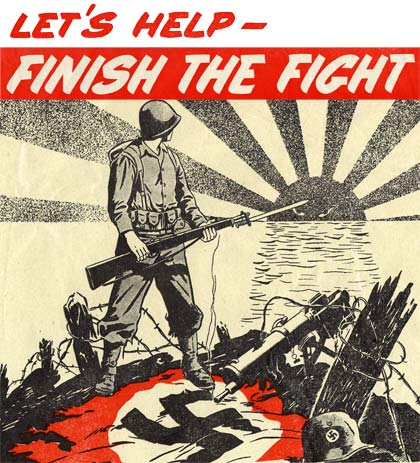 Officials worried about a letdown after defeating Germany. Posters and publications exhorted Americans to continue working for victory over Japan. (Oversize Records, Defense Council Records, OSA)
Enlarge image
Officials worried about a letdown after defeating Germany. Posters and publications exhorted Americans to continue working for victory over Japan. (Oversize Records, Defense Council Records, OSA)
Enlarge image Several months separated the Allied victories over Germany and Japan in 1945. Following the collapse of the Nazi forces in May 1945, the Allies, led by the United States and Great Britain, turned their attention to the defeat of Japan and the final act of the war. Based on the refusal of Japanese defenders on western Pacific islands to surrender and the suicide tactics of kamikaze pilots, many experts predicted a long string of gruesome battles similar to those fought on Iwo Jima. Some thought the war could continue for more than a year and cost tens of thousands of American lives to win. But the atomic bomb, newly developed and tested by the super secret Manhattan Project, was ready for use. New president Harry Truman had to make a terrible decision: Fight the war conventionally and surely witness the deaths of countless Allied and Japanese troops and civilians or unleash the awesome power of the atom on Japanese cities and cause the deaths of untold Japanese civilians, hoping to trigger a surrender. Truman's controversial decision, and the bombs dropped on Hiroshima and Nagasaki in early August, ushered in the Atomic Age and within days ended World War II.
V-E Day Challenges
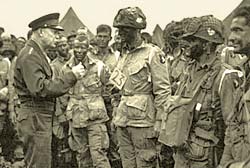 General Dwight D. Eisenhower (left), shown before D-Day, led the Allied effort in Europe.
General Dwight D. Eisenhower (left), shown before D-Day, led the Allied effort in Europe. Events in the European Theater moved quickly in early 1945 after the Allies withstood the last major gasp of Nazi resistance at the Battle of the Bulge. While the Allied forces tightened the noose on Germany and the end of the fascist regime became just a matter of time, military and home front officials planned for the inevitable V-E [Victory in Europe] Day to mark the German surrender. They also thought about how to keep troops and home front workers motivated to "finish the fight" against Japan. There were good reasons to fear complacency and burnout on the home front. The war had dragged on for years and Americans were weary of the endless overtime, war bond drives, rationing and sacrifices. Officials needed to convince civilians to not rest on the laurels of victory in Europe when there was still work to be done: more victory ships to build, more war bonds to buy, and more materials to salvage. Literature distributed as part of a statewide Shriner's Hospital salvage drive in June 1945 spelled out, in blatantly racist terms, the challenge ahead:
Officials Issue Calls for a "Sober" Observance
Many communities adopted a "V-E Day Code of Conduct" in an effort to tamp down excessive enthusiasm and keep citizens focused on the work ahead. One such code included pleas that "the steady flow of airplanes, ships and other materials should not be interrupted by unrestrained celebration causing let-down or absenteeism in the war plants...." The code told citizens that "the announcement of the termination of hostilities in Germany should be received with prayerful thanksgiving and with gratitude that the further sacrifice of human life for the defeat of the Axis Powers in Europe is no longer necessary." Instead, the code called for a "rededication to the unfinished task of defeating the Japanese aggressor in the Pacific" and reminded readers that:
 Governor Earl Snell, shown above in a lighter moment, asked Oregonians for a prayerful V-E Day. (Governors Photographs, OSA)
Governor Earl Snell, shown above in a lighter moment, asked Oregonians for a prayerful V-E Day. (Governors Photographs, OSA) During an early May 1945 radio talk, Governor Snell echoed calls for a subdued reaction to V-E Day. He asked Oregonians to join him in a prayer of thanksgiving for the victory in Europe and a prayer for early victory in the Pacific. Snell reminded citizens that "we must not forget that our boys are still out in the far Pacific fighting for our freedom at this very hour." He called on Oregonians to set even more production records "until the Japanese join their comrades of Nazi tyranny in unconditional surrender." When asked how long the war would last, Snell demurred, but did state that "various estimates on the part of those who should be qualified to predict [are] running from six months to nearly three years." He also cautioned Oregonians that the new "concentration of activities here on the West coast" would cause more hardships. More soldiers and sailors would mean that the "transportation facilities likely will be taxed to the utmost." And he warned residents to prepare for the "certain cutbacks in the production of war goods and materials which will have some effect no doubt upon the social and economic life of the people of Oregon."
Footnote
3 Focused on the Work Ahead
Actual events and actions when V-E Day arrived on May 8, 1945 generally followed the pattern hoped for by officials. In Portland churches were open for prayer and special services were held. In order to encourage the proper reaction, liquor stores were locked up as were most downtown businesses and stores. But city offices, courthouses, schools, post offices and similar venues were open. Highlighting the rededication to finishing the war, the shipyards were open and, according to
The Oregonian newspaper, they "operated with renewed zeal." While absenteeism was normally a chronic problem, on V-E Day the "Swan Island yard reported even more than the normal complement of workers on the job."
 Victory in Europe finally came May 1945. (The Oregonian, May 8, 1945, Page 1) (
Victory in Europe finally came May 1945. (The Oregonian, May 8, 1945, Page 1) ( Listen to a V-E Day radio report - via youtube.com)
Listen to a V-E Day radio report - via youtube.com) A large crowd did gather for a scheduled event at the Victory Center in Portland. But according to reports, people "felt little cause for jubilation." Instead, they listened "soberly and with a strange stillness" to a civic program of prayers, addresses by government leaders, and music. They heard Portland Mayor Earl Riley summarize the official view: "We have work to do, ships to build, bonds to buy, blood to give. Today we pause; tomorrow we resume." As a counterpoint, editors at
The Oregonian had heard enough of government leaders "scolding" citizens about avoiding "immoderate celebration." Writing that "our concern...should be with the lack of exuberance rather than any excess of it," the editors made the case that considering the heroic victory over the Nazis, "there is every reason why V-E day should be a day of true celebration."
Footnote
4 V-J Day Finally Arrives
The mood of Oregonians surrounding the surrender of Japan in the middle of August took a more boisterous tone than the subdued events of V-E Day. Certainly, people were shocked by the power and destruction of the atomic bombs dropped on Japan days before. But the consensus was that the bombs were a necessary evil needed to quickly end the war and save American lives. This attitude was reinforced after people read or heard about the desperate, no-surrender mindset of enemy fighters encountered by Allied forces as they island-hopped in the direction of Japan. Most people moved quickly from imagining of the horror of people being instantly vaporized or dying slow deaths from radiation poisoning in Hiroshima to excited anticipation of the official announcement of Japanese surrender. The announcement finally came on Aug. 14, 1945.
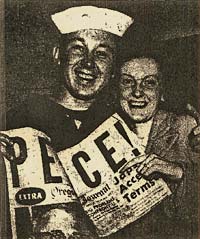 A sailor from Minnesota and a Portland woman hold up a newspaper announcing "Peace!" (Oregon
Journal, August 15, 1945)
A sailor from Minnesota and a Portland woman hold up a newspaper announcing "Peace!" (Oregon
Journal, August 15, 1945)
Once again, state and local officials worried about celebrations turning into riots, only this time they couldn't use the argument that "the war job was only half done" to tamp down the exuberance. Still, on Aug. 9, 1945, Brigadier General Raymond Olson, the acting Adjutant General of the Oregon Military Department, had advice for Governor Snell. Obviously worried about the effect of alcohol on celebrations, Olson counseled Snell to issue a proclamation closing all liquor stores in the state. He also urged the governor to call on citizens to be "sober and patriotic," by attending church services and offering thanksgiving prayers. Snell took much of Olson's advice as he followed the lead of President Truman in declaring August 15 and 16 to be legal holidays. In addition to closing the liquor stores, Snell closed all public buildings and asked that business activity be suspended as much as possible. While he made no mention of "sober" observances of the holidays, he did ask that the "rejoicing be tempered with compassion and prayer for the loved ones of those who have made the supreme sacrifice."
Footnote
5
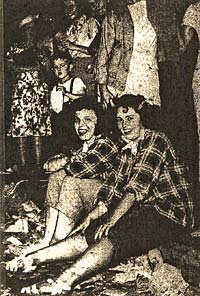 Donna Jean Ryan of Portland (left) and Dorothy Langdon of Coos Bay sit down for a brief rest during Portland celebrations triggered by Japan's surrender on Aug. 14. (Oregon
Journal, Aug. 15, 1945)
Donna Jean Ryan of Portland (left) and Dorothy Langdon of Coos Bay sit down for a brief rest during Portland celebrations triggered by Japan's surrender on Aug. 14. (Oregon
Journal, Aug. 15, 1945) Others took precautions in anticipation of V-J Day as well. The Portland Retail Trade Bureau called on its members to close for the holidays. The bureau took the further step of sending out a bulletin "requesting that all merchants remove things from their display windows and where possible either pull down a blind or shade the window at such a height that people from the street would not be able to glance in over the blind and see anything that might be on display." The bureau also asked that there be "a representative on duty in each store who would be able to handle any disturbances in case they should arise." Meanwhile, the Veterans' Guard and Patrol in Portland was planning to "immediately put from two to five men in plain clothes in each of the hotels and also have a patrol around the various theaters to handle the situation." Portland Mayor Riley issued his own proclamation calling on all "dispensers of beer" in the city to suspend sales. All State Guard personnel were to be available for duty if the governor needed their help. Moreover, police forces in the area cancelled leaves and set strategies for dealing with trouble. According to General Olson, "the Portland Police Bureau figures on maintaining a heavy patrol in the Albina area to take care of the Negro situation and [Multnomah County] Sherrif [sic] Martin Pratt figures on a very rigid patrol of the Vanport area."
Footnote
6
While Portland and other Oregon cities experienced no significant violence during the victory celebrations, officials were right to be vigilant. By the night of Wednesday, August 15, the death toll related to celebrations reached 26 in the United States. San Francisco experienced some of the worst violence as events escalated beyond control on Tuesday, August 14 after people read headlines proclaiming "Tokyo says: Japs quit!" According to Associated Press reports, "milling soldiers, sailors and civilians ripped up war bond booths and started a bonfire in the middle of Market street. Flames roared up 30 feet high before fire trucks inched through the thousands of boisterous people to douse the blaze." The next night riot squads of 3,200 police and shore patrolmen were called out to quell "a mob of celebrants who inflicted heavy damage on downtown property." According to reports, every window along a busy three block stretch of Market Street was broken and five people died in the San Francisco violence. Several others died in New York City where at least 890 people "were treated for injuries or alcoholism."
Footnote
7
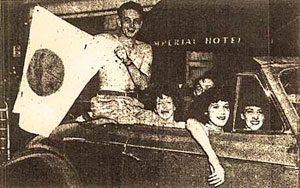 A Vancouver veteran holds up a Japanese flag he "captured" while serving in New Guinea. The soldier was joined during the evening of August 14 by countless celebrants in downtown Portland. (Oregon
Journal, Aug. 15, 1945)
A Vancouver veteran holds up a Japanese flag he "captured" while serving in New Guinea. The soldier was joined during the evening of August 14 by countless celebrants in downtown Portland. (Oregon
Journal, Aug. 15, 1945) While incidents of violence occurred across the country, most celebrants showed their pleasure with dancing, shouting, kissing, and ear-to-ear grins seemingly frozen across their faces. Portland's celebrations began in earnest just after midnight on August 14 as unofficial announcement of the imminent surrender spread. Most of the celebration developed along Broadway in the downtown area where an impromptu parade formed, including 200 marchers, "many flourishing bottles, and a continuous two-direction parade of cars with horns sounding almost constantly." The afternoon of August 14 saw more celebrations as the official announcement of the end of the war was made by President Truman amid a "joyous bedlam" of laughter, blaring horns, and confetti that rained down from buildings. According to
The Oregonian, "girls kissed sailors to signify their joy at the end of the war, and particularly exuberant sailors kissed girls at random." Firecrackers were heard in all parts of Portland but nowhere more than in Chinatown where people of Chinese descent had saved their fireworks for years to celebrate the defeat of Japan, which first invaded Manchuria in 1931. By Thursday, the celebration continued "but a great deal of the steam had gone out of it." Similar events broke out across Oregon as the pent up energy of years of war finally found its release.
Footnote
8 (
 Watch San Francisco V-J day celebrations
Watch San Francisco V-J day celebrations - via youtube.com)
Related Documents
Notes